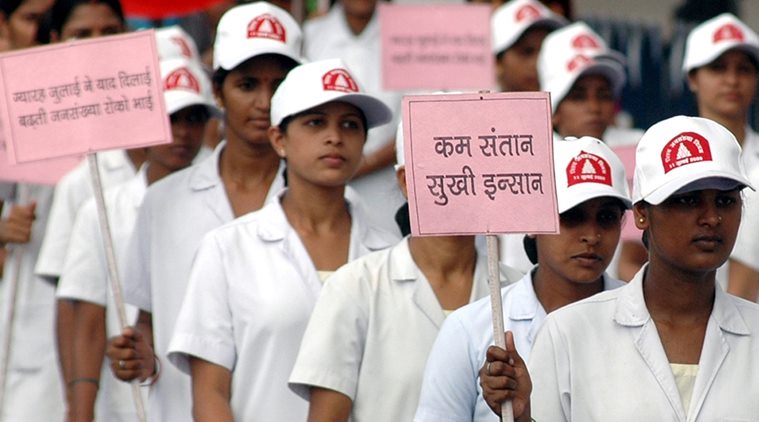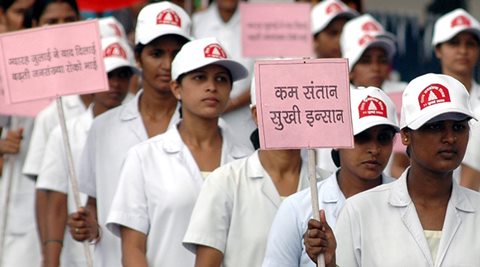 Students of different colleges making a human chain in Lucknow on the occasion of World Population Day in front of the state assembly on Saturday.(Express/Mayank Saxena)
Students of different colleges making a human chain in Lucknow on the occasion of World Population Day in front of the state assembly on Saturday.(Express/Mayank Saxena)
At the recent International Conference on Family Planning, Indian health ministry officials committed to make available better quality family planning services and expanding contraceptive choices. How much of that will translate into action will depend on the money allocated to health care in this budget.
India has promised to meet the FP2020 goal of providing 48 million additional women and girls in the country with access to modern contraceptives by 2020. Family Planning 2020 is a global partnership that is working with governments, civil society, donors and the private sector to enable 120 million women and girls to decide for themselves, whether, when, and how many children they want.

Reaching 48 million, however, seems like a tall order. India spends just 1.3% of the GDP on health care, which is lower than other countries. China, for instance, spends 2.8% and South Africa 4.1%. Budget 2014-15 saw an 87% drop in funds allocated to family welfare and this was reduced even further by 34% in 2015-16.
The low priority is baffling given that India has among the worst maternal and infant mortality rates in the world. The role family planning plays in achieving broader development goals, including poverty reduction has been well documented.
[related-post]
Population Foundation of India figures show that 46% couples in India do not practise family planning, About 21% of births every year are unplanned, due to lack of access to contraceptives. The cost of unplanned children, according to a PFI study ranges from 2% of state GDP in Tamil Nadu to 14% in Bihar.
In this context, the Health Ministry’s decision to introduce injectable contraceptives in government health centres is a welcome move. The decision was pending for nearly 15 years due to protests from many women’s rights groups. It also plans to promote spacing methods and improve quality of care.
“Meeting the FP2020 goal would need an investment of approximately Rs 13500 crore over seven years (2014 to 2020),” points out Poonam Muttreja, Executive Director, Population Foundation of India. An additional Rs 11,150 crores would be needed over the next four years, which is Rs 2,800 crores per year, Muttreja added.
Supplying injectables alone will not is be enough say experts. The government needs to rethink its approach towards family planning.
“If you are talking of FP2020 goals, a lot depends on involving men,” says Ashok Dyalchand, Director, Institute of Health Management in Pachod, Maharashtra. “Not enough has been done to involve men and you have a significant proportion of women using contraception without their husbands’ knowledge.”
“The emphasis has been largely on methods for women historically,” said Muttreja. “The public health system, FP programmes and communication strategies have to change to encourage male engagement.”
For decades India has depended on female sterilization as a means of contraception. It conducts the highest number of tubal ligations – nearly five million in a year. Data from the first phase of the National Family Health Survey (NFHS-4) shows that female sterilisation accounts for 34% of modern contraceptive methods, while less than 1% men go for a vasectomy
One of the main reasons for the low prevalence are the many myths and misconceptions relating to vasectomy says Emily Jane Sullivan from the London School of Hygiene and Tropical Medicines.
“A tubal ligation is a more complicated, costly, and risky procedure than vasectomy,” said Sullivan. “However, in India, more than 1 in 3 women choose to have a tubal ligation while only 1 in 100 men choose to have a vasectomy.”
Countries like Bhutan, Brazil, Nepal, and Rwanda have countered these myths effectively through campaigns that frame men who choose vasectomy as responsible and caring towards their families.
Most Read 1India vs South Africa, World Cup 2023 Highlights: Kohli’s century, Jadeja’s fifer help India beat South Africa by 243 runs 2Bengaluru murder: Police arrest senior geologist’s former car driver 3Diwali 2023 Date: When is Diwali in 2023? 4‘Daughter’s wedding in December…but now I have no house’: 17 families in limbo as HC sets Kabul House eviction date 5After ‘letter’ to Foxconn to move AirPod unit to Bengaluru goes viral, Karnataka Deputy CM Shivakumar files complaint
“There is an opportunity for these countries to share their ‘lessons learned’ with other national family planning programs that are looking to thoughtfully, ethically, and effectively promote vasectomy,” says Sullivan.
India needs to look at similar approaches instead of simply adding more to the basket of choices say experts. “The only addition to the basket is injectables. We do not have male contraceptives. I am in favour of injectables but whether diligence will go into administering it in the government sector is a concern. There is also the question of a strong provider preference towards tubectomies,” cautioned Dyalchand.
Also ReadUnion Budget 2023 income tax slabs: New tax regime is default, rebate inc…Renewed thrust on capex: Outlay hiked 33% to Rs 10 lakh croreExpectations from digital and technological applications in education and…FM radio industry has flourished, 388 private stations in 2022 June quart…
For decades India has followed targets and incentives based approach towards family planning. Achieving the FP2020 goal involves a shift away from that. It is not just about technical solutions or contraception, but also about women’s agency, choice, quality of reproductive health services and dignity.



